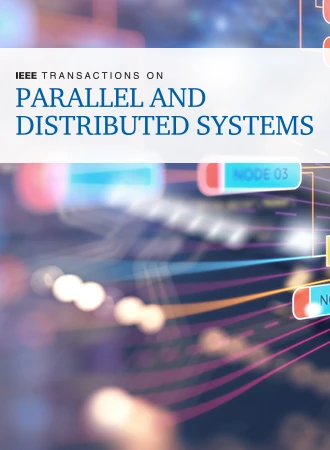将 RNA-RNA 相互作用提升到机器峰值
IF 5.6
2区 计算机科学
Q1 COMPUTER SCIENCE, THEORY & METHODS
IEEE Transactions on Parallel and Distributed Systems
Pub Date : 2024-03-21
DOI:10.1109/TPDS.2024.3380443
引用次数: 0
摘要
RNA-RNA 相互作用(RRIs)在许多生物过程中都至关重要,包括基因转录、翻译和定位。它们在癌症和阿尔茨海默氏症等疾病中起着至关重要的作用。建立 RRI 模型的算法通常使用动态编程,在时间上具有 $\Theta (N^{3} \, M^{3})$ 的复杂度,在空间上具有 $\Theta (N^{2} \, M^{2})$ 的复杂度,其中 $N$ 和 $M$ 是两个 RNA 序列的长度。因此,将它们并行化既重要又具有挑战性。以往的并行化工作都是手工优化,容易出现人为错误,而且开发和维护成本高昂。本文介绍了一种由用户引导的多面体代码生成工具 AlphaZ 生成的多核 CPU 并行化 BPMax 算法,它是较简单的 RRI 算法之一。用户从动态编程算法的数学规范开始,提供多面体程序变换的选择,如时间表、内存映射和多级平铺。AlphaZ 可自动生成高度优化的代码。在最底层,我们实现了一个小型手工优化的寄存器平铺 "矩阵 max-plus "内核,并将其与工具生成的优化代码集成在一起。我们的最终优化程序版本比基础程序快约 400 倍,约为 312 GFLOPS,超过我们平台 Roofline Machine Peak (RMP) 性能的一半。在单核上,我们达到了 RMP 的 80%。算法中的主内核复杂度为 $\Theta (N^{3} \, M^{3})$,在单核上达到 58 GFLOPS,在多核上达到 344 GFLOPS(分别为 RMP 的 90% 和 58%)。本文章由计算机程序翻译,如有差异,请以英文原文为准。
Taking RNA-RNA Interaction to Machine Peak
RNA-RNA interactions (RRIs) are essential in many biological processes, including gene transcription, translation, and localization. They play a critical role in diseases such as cancer and Alzheimer’s. Algorithms to model RRI typically use dynamic programming and have the complexity
$\Theta (N^{3} \, M^{3})$ $\Theta (N^{2} \, M^{2})$ $N$ $M$ AlphaZ
. The user starts with a mathematical specification of the dynamic programming algorithm and provides the choice of polyhedral program transformations such as schedules, memory-maps, and multi-level tiling.
AlphaZ
automatically generates highly optimized code. At the lowest level, we implemented a small hand-optimized register-tiled “matrix max-plus” kernel and integrated it with our tool-generated optimized code. Our final optimized program version is about
$400\times$ RMP
) performance. On a single core, we attain 80% of
RMP
. The main kernel in the algorithm, whose complexity is
$\Theta (N^{3} \, M^{3})$ RMP
, respectively).
求助全文
通过发布文献求助,成功后即可免费获取论文全文。
去求助
来源期刊

IEEE Transactions on Parallel and Distributed Systems
工程技术-工程:电子与电气
CiteScore
11.00
自引率
9.40%
发文量
281
审稿时长
5.6 months
期刊介绍:
IEEE Transactions on Parallel and Distributed Systems (TPDS) is published monthly. It publishes a range of papers, comments on previously published papers, and survey articles that deal with the parallel and distributed systems research areas of current importance to our readers. Particular areas of interest include, but are not limited to:
a) Parallel and distributed algorithms, focusing on topics such as: models of computation; numerical, combinatorial, and data-intensive parallel algorithms, scalability of algorithms and data structures for parallel and distributed systems, communication and synchronization protocols, network algorithms, scheduling, and load balancing.
b) Applications of parallel and distributed computing, including computational and data-enabled science and engineering, big data applications, parallel crowd sourcing, large-scale social network analysis, management of big data, cloud and grid computing, scientific and biomedical applications, mobile computing, and cyber-physical systems.
c) Parallel and distributed architectures, including architectures for instruction-level and thread-level parallelism; design, analysis, implementation, fault resilience and performance measurements of multiple-processor systems; multicore processors, heterogeneous many-core systems; petascale and exascale systems designs; novel big data architectures; special purpose architectures, including graphics processors, signal processors, network processors, media accelerators, and other special purpose processors and accelerators; impact of technology on architecture; network and interconnect architectures; parallel I/O and storage systems; architecture of the memory hierarchy; power-efficient and green computing architectures; dependable architectures; and performance modeling and evaluation.
d) Parallel and distributed software, including parallel and multicore programming languages and compilers, runtime systems, operating systems, Internet computing and web services, resource management including green computing, middleware for grids, clouds, and data centers, libraries, performance modeling and evaluation, parallel programming paradigms, and programming environments and tools.
 求助内容:
求助内容: 应助结果提醒方式:
应助结果提醒方式:


